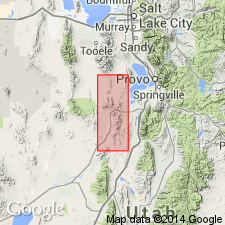
- Usage in publication:
-
- Paymaster member*
- Modifications:
-
- Named
- Dominant lithology:
-
- Limestone
- Shale
- Quartzite
- AAPG geologic province:
-
- Great Basin province
- Wasatch uplift
Summary:
Named as a member of Great Blue formation for Paymaster Hill in sec 20, T9S, R2W, Utah Co, UT, on the Wasatch uplift. Type section measured on north side Edwards Canyon, North Tintic district in N1/2 NE1/4 sec 6, T9S, R3W, Tooele Co, Great Basin province, where a section 623 ft thick conformably overlies Topliff limestone member (new) of Great Blue and conformably underlies Chiulos member (new) of Great Blue. Composed mostly of limestone but also has interbedded olive-green shale and quartzite. Base placed at base of first shale or quartzite above a thick section of limestone. Top placed at base of massive brownish or gray green weathering black shale of Chiulos. Nodules, pods, and thin layers of chert are common. At the type, the limestone is medium gray, generally fine grained but may be medium grained and may also be silty, dolomitic, argillaceous. Quartzite is fine to medium grained, banded, olive green, brown, tan, and pink. Shale is commonly concealed by soil. Because of differential weathering of lithologies, member has a ribbed or corrugated surface. Is of Late Mississippian age. Geologic map. Cross sections.
Source: GNU records (USGS DDS-6; Denver GNULEX).
For more information, please contact Nancy Stamm, Geologic Names Committee Secretary.
Asterisk (*) indicates published by U.S. Geological Survey authors.
"No current usage" (†) implies that a name has been abandoned or has fallen into disuse. Former usage and, if known, replacement name given in parentheses ( ).
Slash (/) indicates name conflicts with nomenclatural guidelines (CSN, 1933; ACSN, 1961, 1970; NACSN, 1983, 2005, 2021). May be explained within brackets ([ ]).

